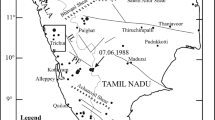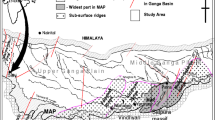Abstract
The Churachandpur-Mao Fault (CMF), trending NNE-SSW, is morphogenic in nature and can be traced for ~ 300 km. It is defined by straight valleys; most prominent being between Kangpokpi and Maram. The fault takes a north-easterly trend from Maram where the fault zone is characterized by active landslides during the monsoon. At Puni Pfosemai, which represents the hanging wall of the fault, extensional tectonics of local extent is observed. This is designated the Puni Pfosemai Fault that trends NNE-SSW and is about 2.5 km in length. The downthrown block is characterized by single-order streams with steep gradients. In the downstream, the fault scarp facing SE developed in the footwall block is more than 100 m in height. The upper portion of the Barak River is tectonically controlled. The SW flowing Barak River takes an almost 360° turn at Karong to flow NNE, before changing course again towards the northwest near Maram. The immediate hanging wall of the CMF is characterized by a narrow valley with relatively high stream-gradient index and steepness index values. A strath terrace of 11 m height is observed on the hanging wall block of the CMF. The straight river valley and concavity (θ) of 0.64 for the Barak River are indicative of active tectonics.












Similar content being viewed by others
References
Acharyya SK (1986) Tectono-stratigraphic history of Naga Hills ophiolites. Geol Sur India Memoir 119:94–103
Adams J (1980) Active tilting of the United States midcontinent: geodetic and geomorphologic evidence. Geology 8:442–446
Aier I, Luirei K, Bhakuni SS, Thong GT, Kothyari GC (2011) Geomorphic evolution of Medziphema intermontane basin and quaternary deformation in the schuppen belt, Nagaland, NE India. Z Geomorphol 55:247–265
Azor A, Keller EA, Yeats RS (2002) Geomorphic indicators of active fold growth, oak ridge anticline, Ventura basin, southern California. Geol Soc Am Bull 114:745–753
Bhakuni SS, Luirei K, Kothyari GC, Imsong W (2017) Transverse tectonic structural elements across Himalayan mountain front, eastern Arunachal Himalaya, India: implication of superposed landform development on analysis of neotectonics. Geomorphology 282:176–194
Bull WB (1978) Geomorphic tectonic classes of the south front of the San Gabriel Mountains, California. U.S. Geological Survey Contract Report, 14-08-001-G-394. Office of Earthquake, Volcanoes, and Engineering: Menlo Park, CA
Bull WB (2007) Tectonic geomorphology of mountains: a new approach to paleoseismology. Wiley-Blackwell, Oxford, p 328
Bull WB, McFadden LD (1977) Tectonic geomorphology north and south of them Garlock fault, California. In: Doehring DO (eds) Geomorphology in arid regions, Proceedings Eight Annual Geomorphology Symposium SUNY Bringhamton, NY, USA, pp 115–138
Burbank D, Anderson R (2001) Tectonic geomorphology. Blackwell Science, Oxford, p 274
Cox RT (1994) Analysis of drainage-basin symmetry as a rapid technique to identify areas of possible quaternary tilt-block tectonics: an example from the Mississippi embayment. Geol Soc Am Bull 106:571–581
Deffontaines B, Chorowicz J (1991) Principles of drainage basin analysis from multiscource data: application to the structural analysis of the Zaire Basin. Tectonophysics 194:237–263
Dehbozorgi M, Pourkermani M, Arian M, Matkan AA, Motamedi H, Hosseiniast A (2010) Quantitative analysis of relative tectonic activity in the Sarvestan area, central Zargos, Iran. Geomorphology 121:329–341
El Hamdouni R, Irigaray C, Fernández T, Chacón J, Keller EA (2008) Assessment of relative active tectonics, southwest border of the Sierra Nevada (southern Spain). Geomorphology 96:150–173
Flint JJ (1974) Stream gradient as a function of order, magnitude, and discharge. Water Resour Res 10(5):969–973
Goldrick G, Bishop P (2007) Regional analysis of bedrock stream long profiles: evaluation of Hack’s SL form and formulation and assessment of an alternative (the DS form). Earth Planet Sci Lett 32:649–671
Gupta AB, Biswas AK (2000) Geology of Assam. Jour Geol Soc India, Bangalore, p 169
Hack JT (1973) Stream profile analysis and stream-gradient index. USGS J Res 1:421–429
Herren E (1987) Zanskar shear zone: northeast-southwest extension within the higher Himalayas (Ladakh, India). Geology 15:409–413
Ibotombi S (1998) On the geology of Manipur: In: Souvenir, IX Manipur Science Congress, pp 12–19
Ibotombi S (2006) Relative plate motions in and around Manipur and its implications on the tectonic of the Indo-Myanmar ranges. Himal Geol 27:111–122
Keller EA (1986) Investigation of active tectonics: use of surficial earth processes. In: Wallace RE (ed) Active tectonics. National Academy Press, Washington DC, pp 136–147
Keller EA, Pinter N (1996) Active Tectonics: earthquake, uplift, and landscape. Prentice Hall, Upper Saddle River, NJ, p 338
Keller EA, Pinter N (2002) Active tectonics: earthquakes uplift and landscape, 2nd edn. Prentice Hall, NJ, USA, p 362
Kent WN, Dasgupta U (2004) Structural evolution in response to fold and thrust belt tectonics in northern Assam: a key to hydrocarbon exploration in the Jaipur anticline area. Mar Pet Geol 21:785–803
Kesari GK (2011) Geology and mineral resources of Manipur, Mizoram, Nagaland and Tripura. Geol Surv India (Misc Publ) 1(3)
Kumar A, Manichandra S (2007) Landslide studies along the National Highway (NH 39) in Manipur. Nat Hazards 40:603–614
Kumar A, Sanoujam M, Sunil L, Dolendro T (2011) Active deformations at the Churachandpur Mao fault (CMF) in indo Burma ranges: multidisciplinary evidences. Int J Geosci 2:597–609
Kundu B, Gahalaut VK (2013) Tectonic geodesy revealing geodynamic complexity of the indo-Burmese arc region, north East India. Curr Sci 104:920–933
Luirei K, Bhakuni SS (2008) Geomorphic imprints of neotectonic activity along the frontal part of eastern Himalaya, Pasighat, east Siang District, Arunachal Pradesh. J Geol Soc India 71:502–512
Luirei K, Bhakuni SS, Kothyari GC, Tripathi K, Pant PD (2016) Quaternary extensional and compressional tectonics revealed from quaternary landforms along Kosi River valley, outer Kumaun lesser Himalaya, Uttarakhand. Int J Earth Sci 105:965–981
Mackin JH (1948) Concept of the graded river. Geol Soc Am Bull 59:463–512
Maddy D (1997) Uplift driven valley incision and river terrace formation in southern England. J Quat Sci 12:539–545
Mallet FR (1876) On the coalfields of the Naga Hills bordering the Lakhimpur and Sibsagar districts, Assam. Mem Geol Surv India 12(2):266–363
Mathur LP, Evans P (1964) Oil in India. Proceeding of 22nd Session of Int Geol Cong, New Delhi p 7–52
Merritts DJ, Vincent KR (1989) Geomorphic response of coastal streams to low, intermediate, and high rates of uplift, Mendocino triple junction region, northern California. Geol Soc Am Bull 101:1373–1388
Molin P, Fubelli G, Nocentini M, Sperini S, Ignat P, Grecu F, Dramis F (2012) Interaction of mantle dynamics, crustal tectonics and surface processes in the topography of the Romanian Carpathians: a geomorphological approach. Glob Planet Chang. https://doi.org/10.1016/j.gloplacha.2011.05.005
Nandy DR (1976) The Assam Syntaxis of the Himalaya: a re-evaluation. Geol Surv India (Misc Publ) 24:363–368
Nandy DR (2001) Geodynamics of northeastern India and the adjoining region. ACB Publications, Kolkata 209p
Ollier CD (1981) Tectonics and landforms. Longman, London, p 324
Ouchi S (1985) Response of alluvial rivers to slow active tectonic movement. Geol Soc Am Bull 96:504–515
Ramírez-Herrera MT (1998) Geomorphic assessment of active tectonics in the Acambay graben, Mexican volcanic belt. Earth Surf Process Landf 23:317–332
Schoenbohm LM, Whipple KX, Burchfiel BC, Chen L (2004) Geomorphic constraints on surface uplift, exhumation, and plateau growth in the Red River region, Yunnan Province, China. Geol Soc Am Bull 116:895–909
Silva PG, Goy JL, Zazo C, Bardajm T (2003) Fault generated mountain fronts in Southeast Spain: geomorphologic assessment of tectonic and earthquake activity. Geomorphology 250:203–226
Singh CD, Behera KK, Rocky WS (2011) Landslide susceptibility along NH-39 between Karong and Mao, Senapati District, Manipur. J Geol Soc India 78:559–570
Snyder NP, Whipple KX, Tucker GE, Merritts DJ (2000) Landscape response to tectonic forcing: digital elevation model analysis of stream profiles in the Mendocino triple junction region, northern California. Geol Soc Am Bull 112:1250–1263
Stewart IS, Hancock PL (1990) What is fault scarp? Episodes 13:256–263
Stewart IS, Hancock PL (1994) Neotectonics. In: Hancock PL (ed) Continental deformation. Pergamon, Oxford, pp 370–409
Strahler AN (1957) Quantitative analysis of watershed geomorphology. Trans Am Geophys Union 38:913–920
Thakur VC, Rautela P, Jafaruddin M (1995) Normal faults in Panjal thrust zone in lesser Himalaya and between the higher Himalaya crystallines and Chamba sequence in Kashmir Himalaya, India. Proc Indian Acad Sci 104:499–508
Valdiya KS (1988) Tectonics and evolution of the central sector of the Himalaya. Philos Trans R Soc London 326:151–174
Valdiya KS (1992) The main boundary thrust zone of Himalaya, India. In: Bucknam RC, Hancock PL(eds) Major active faults of the world: results of IGCP project 206. Annals Tectonicae 6:pp. 54–84
Verma KP, Gaur MP, Nagarajan K (1984) Report on systematic geological mapping in parts of Manipur north district, Manipur. Geol Surv India (unpublished report) 1984, FS. 1982–1983
Wang Y, Sieh K, Soe TT, Lai KY, Than M (2014) Active tectonics and earthquake potential of the Myanmar region. J Geophys Res Solid Earth 119:3767–3822
Westaway R, Bridgland D, White M (2006) The quaternary uplift history of central southern England: evidence from the terraces of the Solent River system and nearby raised beaches. Quat Sci Rev 25:2212–2250
Whipple KX, Di-Biase RA, Crosby BT (2013) Bedrock rivers. Treatise on Geomorphology Geomorphology 9:550–570
Wobus CW, Hodges KV, Whipple KX (2003) Has focused denudation sustained active thrusting at the Himalayan topographic front? Geology 31:861–864
Acknowledgements
Luirei and Lokho are grateful to the Director, Wadia Institute of Himalayan Geology, Dehradun for providing the necessary facility to carry out the work. GCK is thankful to M. Ravikumar, Director General, and Dr. Sumer Chopra, Director, Institute of Seismological Research for the same. P. Manikho, Shantajhara Biswal, and Imsong Naro are acknowledged for the help extended during fieldwork and in the laboratory.
Author information
Authors and Affiliations
Corresponding author
Rights and permissions
About this article
Cite this article
Luirei, K., Lokho, K. & Kothyari, G.C. Neotectonic activity along the Churachandpur-Mao Fault in and around Karong, Manipur, India: based on morphotectonics and morphometric analyses. Arab J Geosci 11, 571 (2018). https://doi.org/10.1007/s12517-018-3902-y
Received:
Accepted:
Published:
DOI: https://doi.org/10.1007/s12517-018-3902-y




